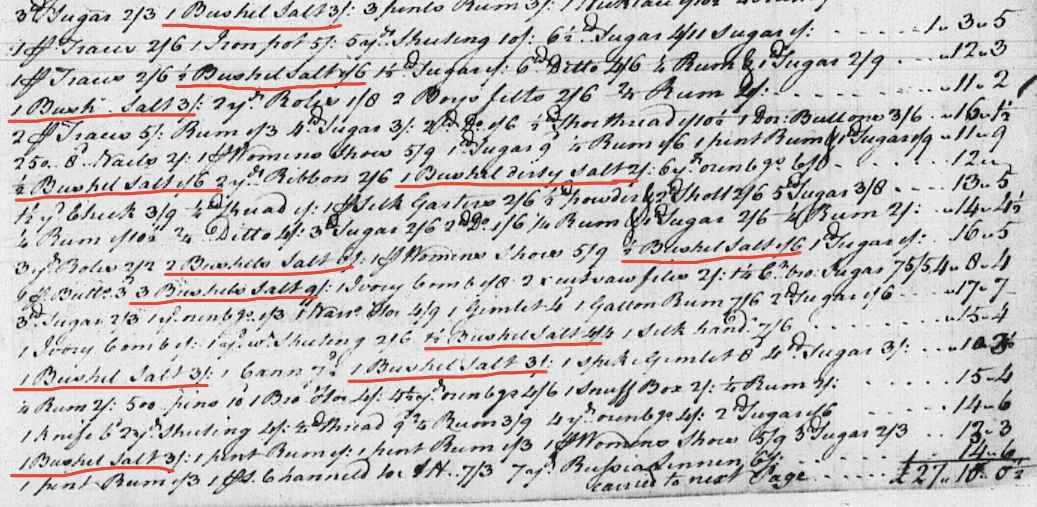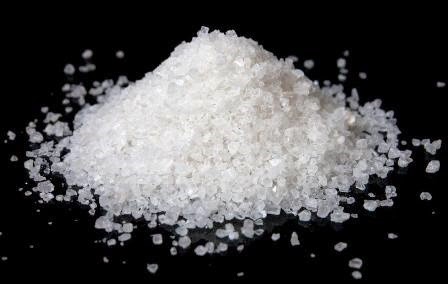Canon Jones // AMH 4112.001 – The Atlantic World, 1400-1900
You never hear salt talked about like other spices used in the 18th century. You never hear some high-class socialite talking in his diary about the shipment of salt he got from some exotic place and how expensive it was. No, you do not hear salt given the credit it respects or deserves. But, I bet you could go anywhere in 18th-century America and find that everyone used salt. This magnificent spice was not just used for cooking or seasoning but had many uses, including as a preservative – let’s see cinnamon or rosemary do that. That’s why you see people buy salt by the barrel or bushel in the Glassford and Henderson Colchester store ledger for 1760-1761.

According to the Ready Money accounts, between October 1760 and December 1761, salt was bought every month.[1] The reason so much salt was ordered and sold was because it was a god send for preserving food. The 18th century did not have the modern refrigeration that we have now, so they had to get creative with how to keep meats and other foods edible longer. Salt helps stabilize the food keeping it fresh for a longer time, especially in the spring and summer.[2] Much of the salt was purchased more in the warmer months because meat goes bad faster when it’s hot, unlike in the cold when you could keep it chilled with the cooler temperatures and that’s how it stayed fresh. The month of October in 1761 there was one bushel of salt bought compared to April of 1761 there were thirteen bushels sold which was the beginning of the hotter months[3].
Now, the salt you see when you open your spice cabinet or look on the counter was not exactly the salt that the 18th century knew. Your Morton’s salt is baby salt compared to this salt. When customers bought salt, it was more like today’s rock salt, salt that was gravel-sized. If you wanted more dainty crushed up salt for cooking, you had to do it yourself. It could be done with a cloth and a mortar and pestle.

By the turn of the 19th century, salt no longer needed to be imported from Europe as “salt was produced between 1790 and 1860, in Louisiana, Michigan, Pennsylvania, Indiana and Missouri by boiling brine in salt furnaces,” since no salt mines had yet been discovered.[4] They did not need to be dependent on getting their salt from Europe, mining it themselves or boiling it was much easier. Regardless of how we got the salt in the 18th century, one of the most common things in the world is (and was) one of the most important. Just remember to stay salty America.
[1] Alexander Henderson, et. al. Ledger 1760-1761, Colchester, Virginia folio 10-13 Debit/Credit, from the John Glassford and Company Records, Manuscript Division, Library of Congress, Washington, D.C., Microfilm Reel 58 (owned by the Mount Vernon Ladies’ Association).
[2] Mickey Parish. “How Do Salt and Sugar Prevent Microbial Spoilage?” Scientific American. 2006. Accessed December 05, 2016. https://www.scientificamerican.com/article/how-do-salt-and-sugar-pre/.
[3] Henderson, et. al. Folio 10 Debit, 11 Credit.
[4] “History of Salt,” History of Salt | SaltWorks®. Accessed November 07, 2016, https://www.seasalt.com/salt-101/history-of-salt.
